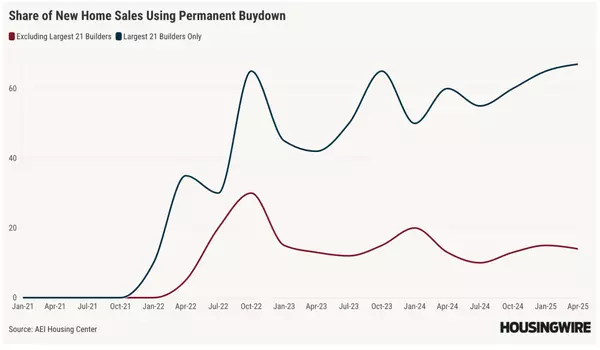Lender Price integrates FOA’s reverse products into marketplace

California-based Lender Price has added its first reverse mortgage partner to its pricing and product eligibility (PPE) platform through an agreement with Finance of America (FOA).Lender Price Marketplace will provide brokers and lenders with live pricing for FOA’s Home Equity Conversion Mortgage (H
Read MoreeXp takes a step toward increased referral fee transparency

National Association of Realtors’ (NAR) leadership may still have a divided view on the disclosure of referral fees, but one national real estate brokerage has come to a firm decision on where it stands. On Tuesday, eXp Realty announced that starting next Monday, Dec. 1, it will be implementing enha
Read MoreMortgage prepayments hit 3.5-year high as borrowers rush to refinance

Mortgage prepayments climbed to their highest level in three and a half years in October as lower interest rates prompted more borrowers to refinance, according to ICE Mortgage Technology’s First Look report. The single-month mortality rate, which measures prepayments, rose to 1.01%, up 16 basis poi
Read MoreFHFA raises 2026 conforming loan limit to $832,750
The baseline conforming loan limit is set to increase by 3.25% in 2026, with Fannie Mae and Freddie Mac now authorized to purchase mortgages up to $832,750 for one-unit properties in most parts of the country, according to the Federal Housing Finance Agency (FHFA). The new limit, aligned with home-p
Read MoreHome buyers see record discounts just in time for Black Friday

Total pending home sales reach multiyear high with mortgage rates near 6%
The housing market experienced a slightly positive shift mid-June and is ending 2025 on even more positive news. Existing home sales have shown four consecutive months of year-over-year growth and our total pending home sales data has just reached a multiyear high for this calendar week. By tracking
Read MoreThe Goldilocks case for home sales in 2026
Home sales are finally showing real momentum as we close out 2025. The trends are consistent enough to inspire me to sketch a Goldilocks case that results in very significant home sales growth 2026. What if we get lucky and the conditions land just right? First the data. The Altos weekly pending sal
Read MoreCompass, Zillow debate irreparable harm at hearing

Thursday marked day three of Compass’s preliminary injunction hearing in its antitrust lawsuit against Zillow. The day featured testimony from Compass executives and expert witnesses. The hearing, which is being held in New York City under the auspices of U.S. District Court Judge Jeanette Vargas, w
Read MoreWith Powell set to move on, who are the candidates for the next Fed chair?

Several candidates have been publicly identified to serve as the next chair of the Federal Reserve, with current Chair Jerome Powell‘s term coming to an end in May. Treasury Secretary Scott Bessent told CNBC’s Sara Eisen in October that he would give President Donald Trump “three or four candidates
Read MoreElsafy Team’s journey to $80M in sales and a new home at Keller Williams

Essam Elsafy, founder of The Elsafy Team, has quietly become one of Wisconsin’s most successful real estate leaders, guiding his team to top statewide rankings. The Whitefish Bay–based group, now nine members strong, ranked No. 3 among Wisconsin medium-sized teams by sales volume in 2024, according
Read MoreMortgage credit report costs could jump 50% in 2026

Credit report prices for mortgage lenders will increase by up to 50% in 2026, despite regulatory efforts to boost competition and recent pricing shifts by some players, resellers told HousingWire. It will mark the fourth consecutive year of higher costs. The increase is tied to credit reports that
Read MoreCompass, Zillow: Who gets to set the rules of online real estate? A judge may soon decide

Compass’s preliminary injunction hearing in its antitrust lawsuit against Zillow continued throughout this week, before finishing up on Friday. The hearing, which is being held in New York City under the auspices of U.S. District Court Judge Jeanette Vargas, will be used to decide Compass’s motion s
Read MoreNYC landlords sue over rent law as vacant units climb

New York City Mayor-elect Zohran Mamdani won after campaigning on expanding rent stabilization to improve housing affordability. When he becomes mayor in January, Mamdani will face a lawsuit challenging New York’s rent stabilization law. A group of New York City landlords sued, arguing that the law
Read MoreGreystar reaches $7M settlement in rent-setting lawsuit

A $7 million settlement agreement with Greystar Management Services was announced by California Attorney General Rob Bonta — part of a coalition of nine state attorneys general pursuing antitrust claims tied to RealPage software. The settlement requires Greystar to stop using software that employs c
Read MorePittsburgh leads affordability, Austin inventory surges

A new HousingWire Data deep-dive confirms widening affordability gaps and rising inventory in previously constrained markets — as well as strong regional patterns that favor the South for balance and the Midwest for price relief. Pittsburgh continues to stand out as the nation’s most affordable majo
Read MoreSenior-held home equity can be a resource for the next generation

Older Americans hold more than $14 trillion in home equity — nearly half the size of the U.S. economy. And while seniors can benefit from tapping their equity through a reverse mortgage product, they can also use the loan proceeds to help family members who might be struggling to afford homeownershi
Read MoreFrom the warming drawer to the freezer: Tariffs, the Supreme Court and housing

As someone who’s spent decades in the mortgage trenches—and as one of the owners of a $1 billion independent mortgage banking company—I’ve seen a few sunrises and sunsets in this industry. The 2008 crisis. Conservatorship. Waves of QE. Worsening LLPA’s. Adverse market fees. The pandemic housing chao
Read MoreOff-site housing: cure or political distraction? Our Denver correspondents weigh in

At The Builder’s Daily Focus on Excellence Conference in Denver, we had a chance over breakfast to discuss what we were seeing in off-site housing. While we have come at this from different angles and have seen different aspects of it, we reached a similar conclusion. Both of us have believed for ye
Read MoreKeller Williams Realty Atlanta partners with Southeast Mortgage of Georgia

Keller Williams Realty Atlanta Partners has entered into a strategic partnership with Southeast Mortgage of Georgia — linking the state’s largest real estate franchise with its largest non-bank mortgage lender. Leaders say the agreement is intended to streamline the home buying and selling process b
Read MoreReal estate agents: throw away the scripts and speak from the heart

For almost 40 years of training real estate agents, one truth has stood out above the rest: memorized scripts don’t move people. In fact, they can actually hold you back and hurt your business. I’ve long been called the “godfather of metaphors and analogies,” and for good reason — it’s the basis of
Read More
Categories
Recent Posts










